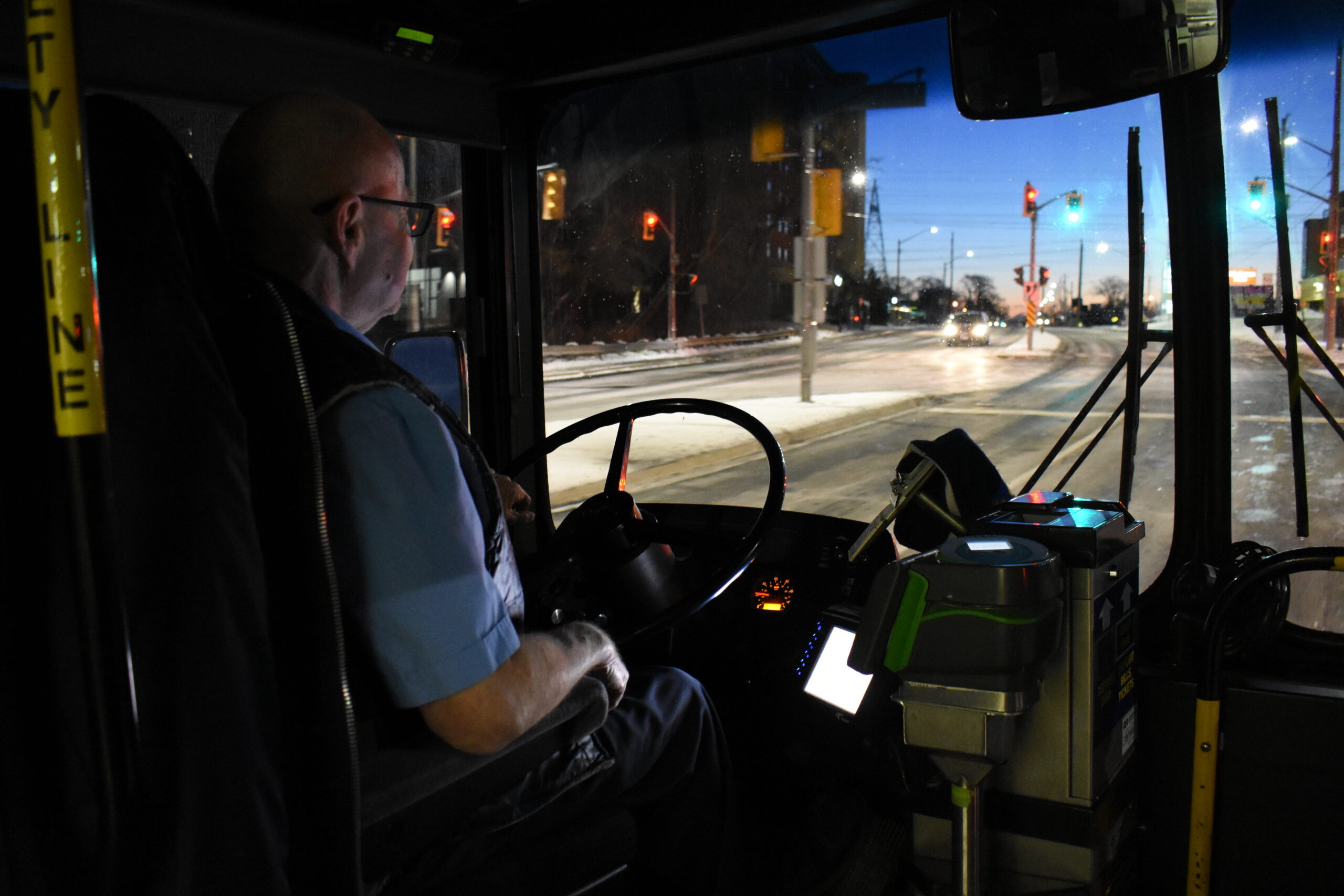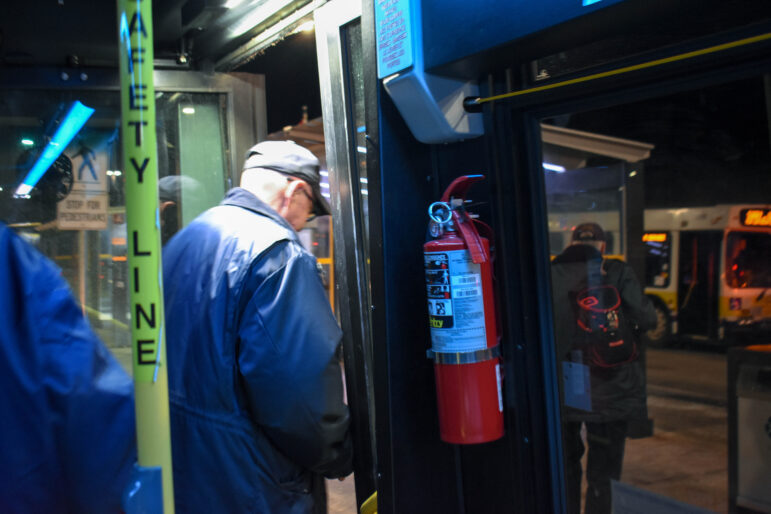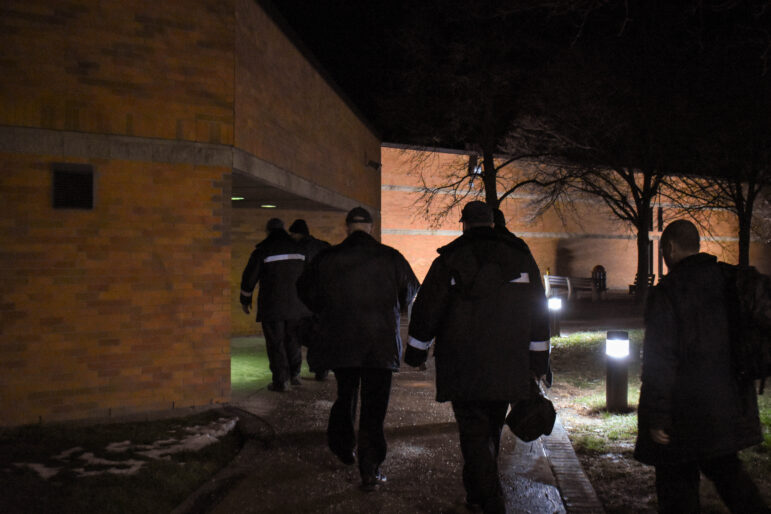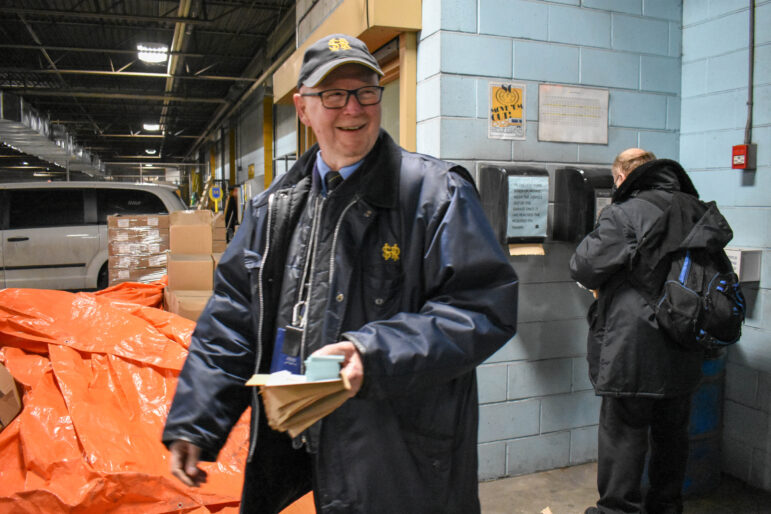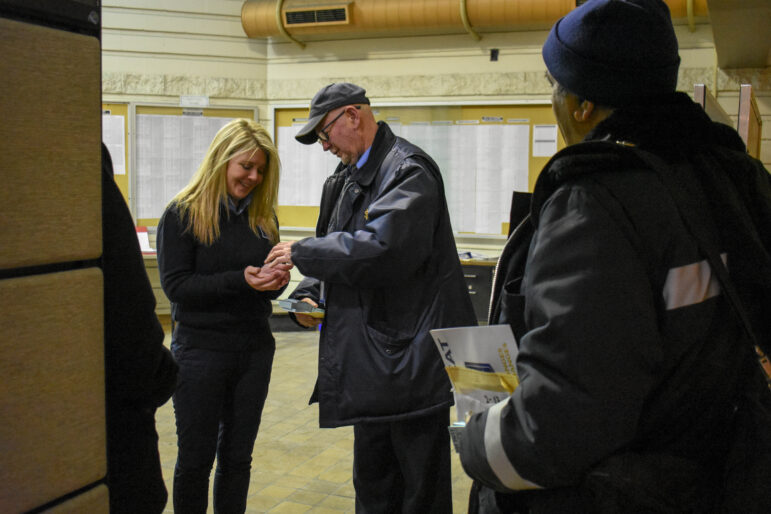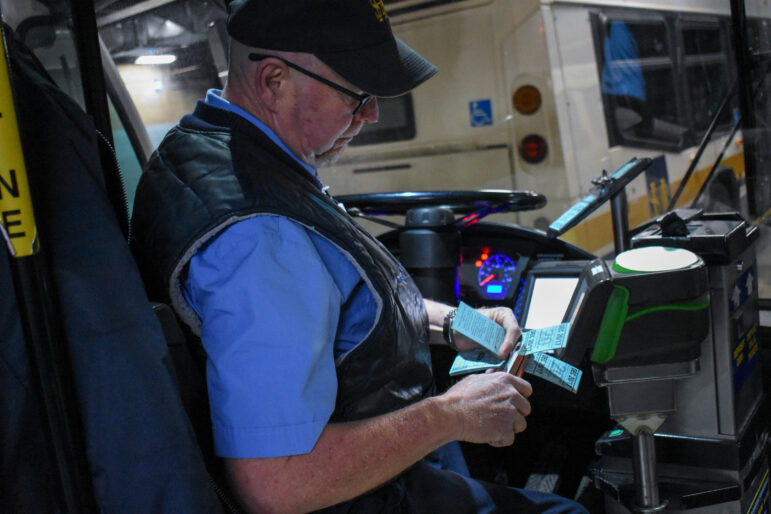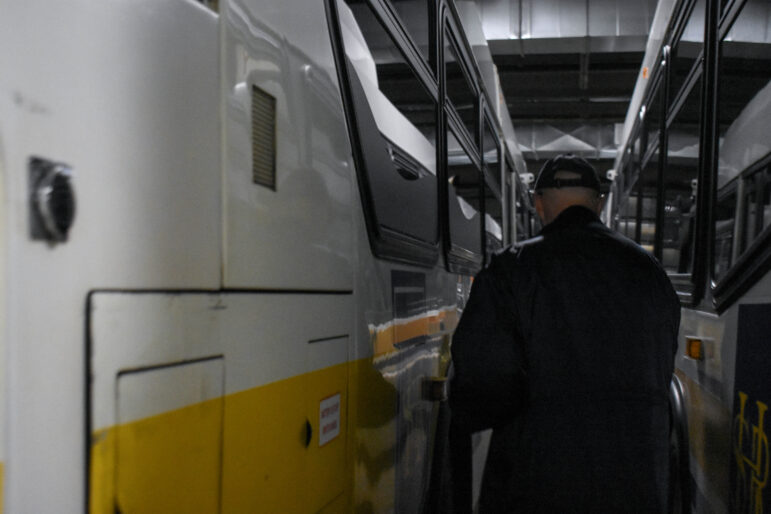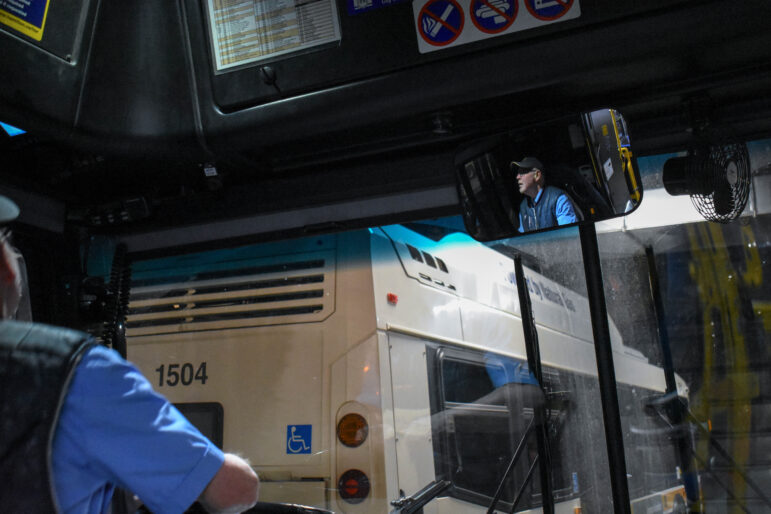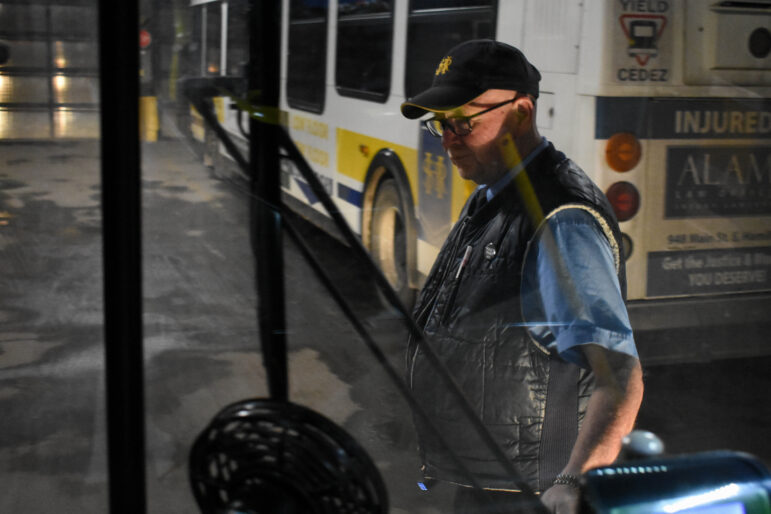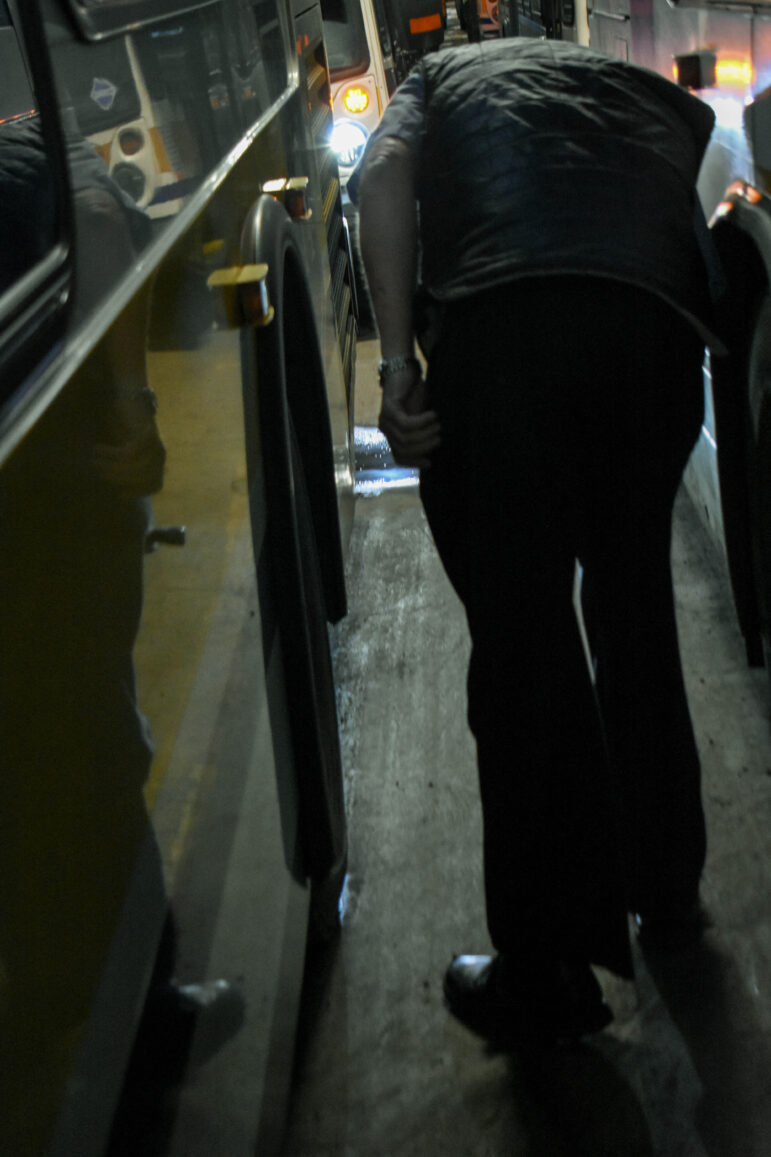Whoever said everyone is replaceable never met HSR’s bubbles and chocolate bus operator.
Every Monday morning, Joe Kipp walked over to the Wentworth Street North offices of the Hamilton Street Railway “looking for an opening as an operator”. It was the mid-1970s and Joe was in his mid-20s.
At the time, the HSR would only hire men older than 25 years of age and they had to be married. “That’s just the way things were then”, Joe says.
It took months of showing up before he was hired, even with “two references who did me well”. His references were Norm Keopke, a senior HSR operator, and a Hamilton Police Sergeant.
Joe started training on June 17, 1978.
After nearly 40 years behind the wheel of a HSR bus, Joe retires tomorrow at 11:57 a.m.
“Full training in those days took about a year to complete”, Joe says. At the time, the HSR ran trolleys, “suburban runs”, and inter-city Canada Coach Lines service.
It was the trolleys that “enamoured” Joe with the HSR. He started operating as a “spare board” operator, filling in for vacation and sick days. He first signed work was a late night 2-Barton. A few months later, with enough seniority, Joe signed work on the 1-King and never looked back.
For the next 20 years, with a few exceptions when he did overtime, Joe stuck to the 1-King. Where most operators quickly move to suburban routes with a few years seniority, Joe loved operating the trolley buses on King.
Even now, nearly 40 years later, when Joe volunteers for extra work, he tries to stay to the old trolley routes of 1-King, 2-Barton, and 3-Cannon.
Joe, A People Person

It’s a cold Wednesday morning when I joined Joe Kipp last week for the start of his shift. Joe leaves his house just after 3:45 a.m. Much like the riders he’ll serve later in the morning, Joe takes the HSR to work.
The HSR is truly a 24/7 operation, between end of service at 2:45 a.m. and resumption of service at 4:30 a.m., the HSR operates shuttle buses to get bus operators to and from the Mountain Transit Centre.
It was only in the past two decades that Joe started taking the HSR to work, for his first two decades, Joe walked to work. First to the HSR garage when it was located at Wentworth Street and King Street, the present site of Cathedral High School. When When the HSR moved in 1989 to 330 Wentworth Street North, he continued to walk. It was only in the late 1990s when the HSR moved to its present Mount Hope location on Upper James Street near the airport and Joe started riding the shuttle.
Joe walks 1.5 kilometres from his house to get the pickup bus at Wellington Street and Main Street. The walk is quiet, other than the odd car and one Liquid Air vehicle, Hamilton’s streets are abandoned at this early hour. Even the local Tim Horton’s is closed.
On this morning, Joe’s the first operator waiting for the bus. Shortly after arriving at the stop, other operators emerge from the darkness and join Joe waiting for the bus.
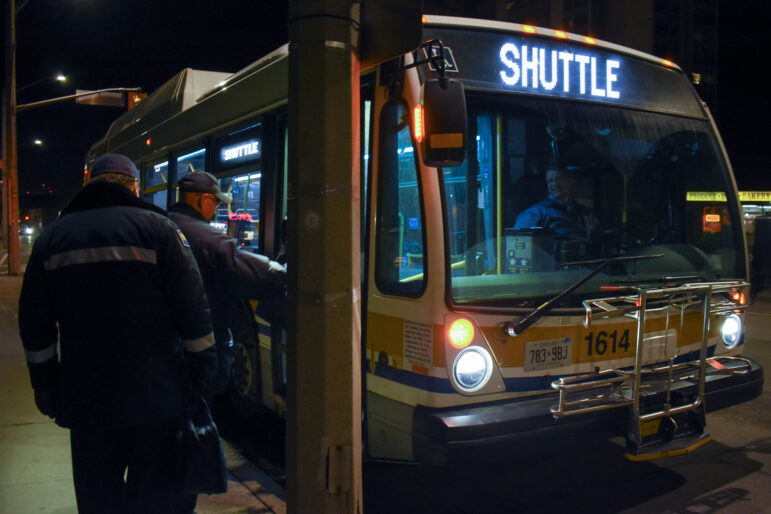
It’s just past 4:15 a.m. when the shuttle bus arrives. “Hey, got any candy for me today!” shouts the shuttle operator with a large smile.
Joe has three signatures he’s known for – a seemingly endless supply of candy is one.
Good nature joking conversation starts immediately among the half-dozen operators on the shuttle. Joe is the centre of attention. Other operators ask who will give out candy when he retires.
Joe’s other signatures are waving at everyone on King, and his bubble machines over the years.
The shuttle travels up the Claremont Access, at Upper James Street and Mohawk Road, more operators board, making about a dozen and a half people on the bus.
Camera shy, nobody sits beside Joe this day, but one of the newly boarded operators asks Joe what candy he has today.
Quickly, like a movie character selling watches on a New York City street, Joe flashes his jacket revealing a cache in his inner pockets. A miniature candy cane is exchanged for a smile.
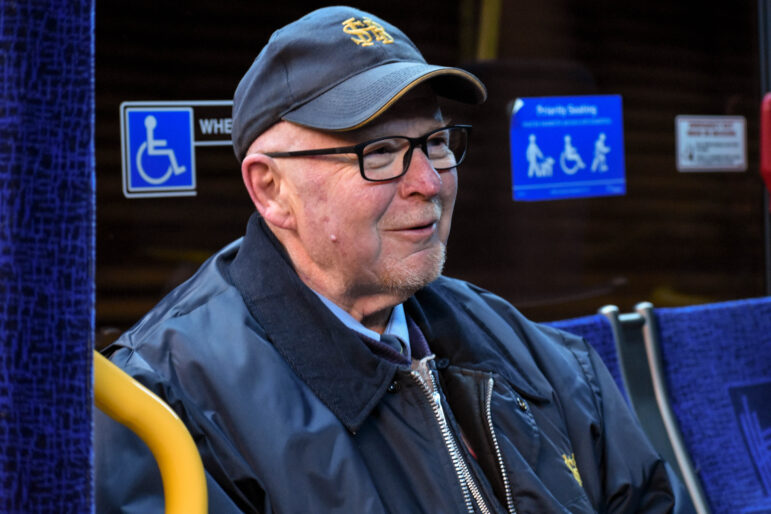
Candy and Bubbles
One of the guys jokes “Hey Joe, you never have candy for me!”, Joe hands him a candy and with a smile shares a lesson he learned early in his career handing out candy “guys just don’t like getting chocolate from other guys”.
Joe shares another bit of wisdom, “colder weather is better for chocolate”.
“At Main and Ottawa eastbound years ago, there was a young girl on her way to school every morning. She quizzed me once about why she never got candy”, Joe says he told her that he need her parents permission.
“The very next morning”, Joe says with a great deal of emphasis, “the young girl emerged from a car parked near the stop with her mother in tow … the youngling had candy for the rest of grade school”.
Joe says over the years, he’s enjoyed driving generations of Glen Brae students to their East End school, saying they are “always extra polite and friendly”.
[In a playful bit of banter to your reporter’s high school origins, Joe says “I’m not too sure about those Glendale students”]
At 4:30 a.m., the pickup shuttle arrives at the Mountain Transit Centre and a steady stream of operators flows into the building.
Just inside the entrance, two dozen squeeze to swipe in for the day, pick up their transfers books, and maintenance slips for the day ahead.
An ironically placed sign overhead says this is a “Quiet Area”, as “report” operators await an HSR Inspector to assign them buses for the day.
For the next few hours, this zone is organized chaos as dispatchers scramble with the daily operator shortage to figure out which buses will or will not be on the road that morning.
Even among this organized chaos of hustling and bustling, Joe is the centre of attention.
A retired operator on report this day, Ken Goobie, sees Joe. With a giant smile, Ken asks “Where’s your bubble toy Joe?!”
A few others operators join in, joking Joe should launch bubbles in the Quiet Zone. Joe says he’s still searching for a replacement after his most recent one broke about a year ago.
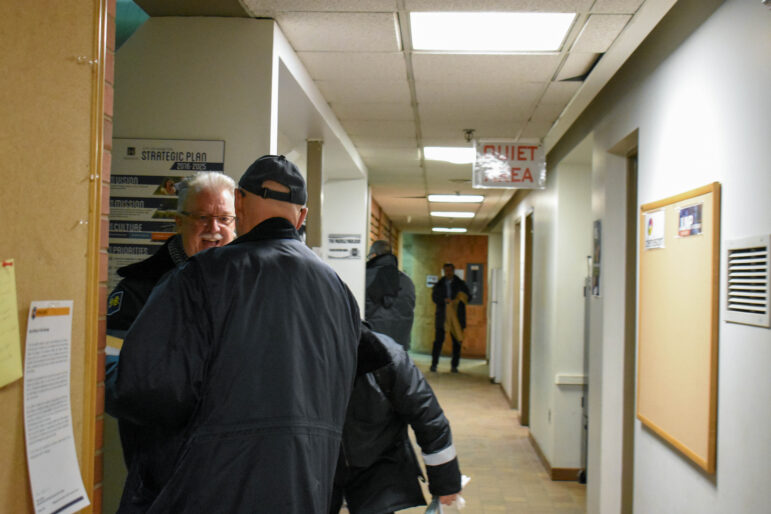
Joe is well known for the bubbles flying out his bus window while stopped at various locations, especially McMaster University.
Joe says he started with the bubbles for kids at the hospital.
The 1A-King end of the line was the front of McMaster Children’s Hospital for nearly 20 years, and Joe would sit there daily. “One day I spotted a bubble machine in a department story, and I had an idea. I’d start blowing bubbles out the front door of the coach”.
“Drum days were replaced with smiles”.
Officially, blowing bubbles out the window is something the HSR frowns upon, but as one HSR mid-manager told me, even they smile seeing Joe’s bubbles flying.
The Stories
“In hindsight, I should have wrote a book” Joe says sharing stories of the past nearly 40 years.
“I have young passengers today whose parents, and in some cases grandparents, also rode my bus”, Joe notes.
Like many of his passengers, Joe lives in Central Hamilton, and has his entire life. He grew up only a few blocks from his present home near General Hospital, and still regularly walks to visit his mother who continues to live in the house he grew up in.
“There was a time a few decades ago when we were having some ongoing problems at night from certain shaddy characters” Joe tells with a look of reminiscence. “The HSR resorted to hiring off duty policemen to ride the bus”.
One night, an off-duty police office saw a suspect he knew with a warrant and made a gunpoint arrest on Joe’s bus, “I’ve had tense moments on the buses but never really felt for my safety”.
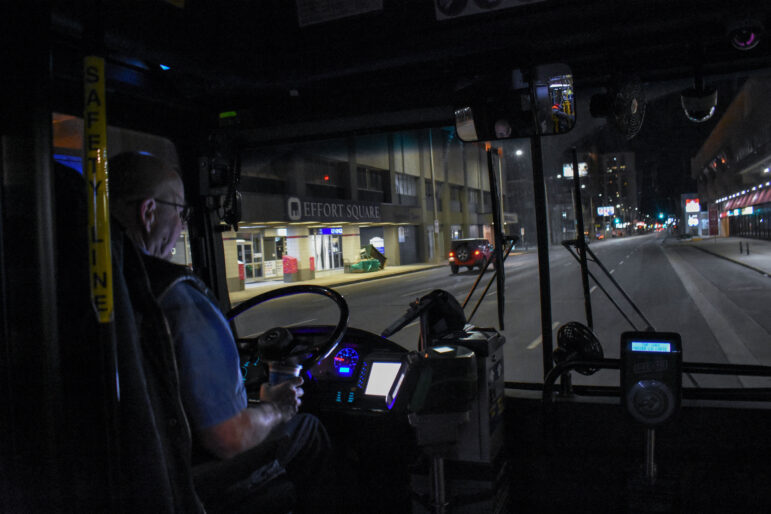
Joe had two buses catch fire on him over the years.
In the early-1990s, he was driving bus #8501 westbound on Queenston Road passing the Zellers Plaza at Nash Road. “Passing cars were blowing their horns at me, trying to get my attention”, Joe says with a smile.
“After stopping one driver yelled out ‘your bus is on fire!’, I didn’t even know”. He got the “seven or so passengers” off the bus and went to the nearest house to call for assistance.
By the time the Fire Department arrived “the fire engulfed the rear of the bus”. Joe explains the floors were made of plywood on this model of bus and the fire spread along the floorboards.
While one fire truck’s crew fought the fire, which Joe describes as causing a thick black smoke that stopped all traffic on Queenston Road, the “young lad” who lived in the house came out “in rubber boots, a red plastic fireman’s hat, and the garden hose” to try to assist the fire department. The engineer of the second pumper on scene gave the child a full tour of the truck.
The bus was a write-off for passenger service, the frame was salvaged and the City’s first Dental Bus was built on it.
“I lost my favourite driving glasses in the blaze”, laments Joe.
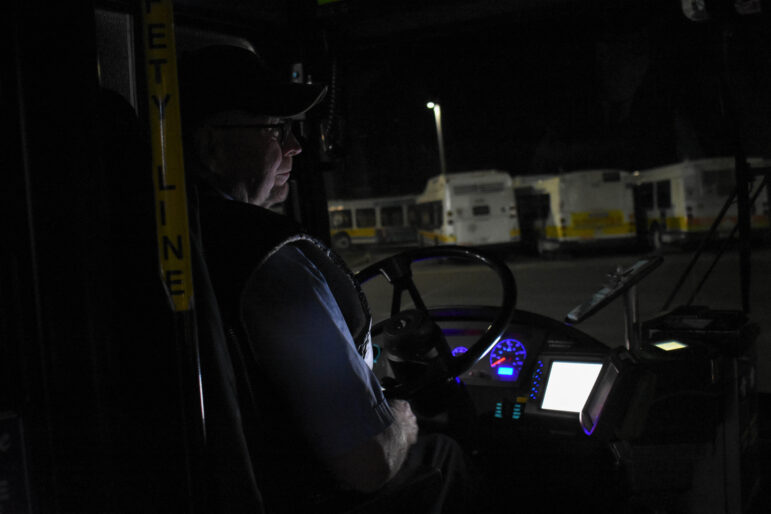
Around seven or eight years ago, Joe had his second bus fire.
Driving down the Red Hill around 4:45 a.m., Joe noticed flames in his rear view mirror.
His “0600 series” bus was shooting flames out the rear tire well. Joe suspects the regenerative breaking system was at fault. The back of the bus was a write-off when the fire was finally out.
The Future of The HSR
Joe’s trained hundreds of operators over his career, including the HSR’s first two female operators.
Joe has simple advice for operators: “Never assume anything, treat people with respect, if you are a hurry and pressed for time, bad things may happen — good things never result from hurrying”.
A Day on Joe’s Bus
Back at the garage at 4:30 a.m., Joe continues to get ready for the day.
Officially, his bus pulls out of the garage at 4:55 a.m., but Joe always makes sure to be on his bus no later than 4:40 a.m. to give extra time for checking the bus.
If he finds a problem with his assigned bus, it gives him time to get another and still be on time for his 5:15 a.m. departure as the third 1-King bus out of the GO Centre.
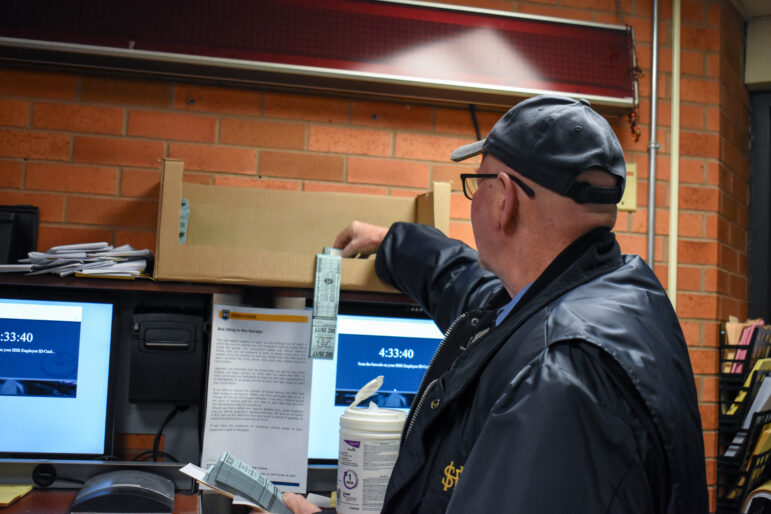
Joe enters the driver’s lounge after swiping in and getting his paperwork and transfers for the day.
As Joe nears retirement, he looks at the current HSR crisis as a “temporary bump for the company”. (The HSR’s full name is The Hamilton Street Railway Company)
He quickly chats with some of the younger operators, including Cindy who recently filled-in on Joe’s work during his summer vacation.
Joe is insistent that your reporter meet the younger operators, “they are the future” he says repeatedly.
“I know Cindy quite well, she has passion and is representative of the upcoming operators who will be here after I and others are long gone”.
“She often covered my work when I’m on vacation, my regular passengers often had nice things to say about her and others”.
While Joe insists he’s replaceable, others (including your reporter) disagree.
Just ask “Friendly Frank, The Singing Bus Driver“. Joe was on medical leave last year and Frank Palin operated Joe’s 1-King bus for the month of May and June.
Frank is one of the HSR’s most popular operators, so much so a GoFundMe campaign organized earlier this year raised over $1000 to thank him for being the friendliness HSR operator.
The campaign was organized by students who regularly ride Frank’s 51-University bus.
On driving Joe’s bus, Frank says “as the weeks go by, passengers would still board each day with either a ‘When’s Joe back’ or ‘Still no Joe?'”.
Frank took it in strive, “It was nice because drivers tend to get a bad rap, to see how beloved Joe is, it restores my faith in the system”.
Frank says Joe was one of the first operators to welcome when he was hired, and he always looks forward to seeing Joe driving through McMaster, bubbles flying out Joe’s window.
“It always made me laugh”, Frank says with a wide smile.
On this day, due to the ongoing Transit Crisis, many retirees are in the lounge on “report” as the HSR scrambles to fulfil scheduled service after Council slashed hiring early in 2017.
Among those awaiting assignment is former Amalgamated Transit Union Local 107 President Kim Cheeseman who led the union during the lengthy 1998/98 winter transit strike.
“I owe him and those who came before him for the good job I have today, for my kids’ education”, Joe says of Cheeseman.
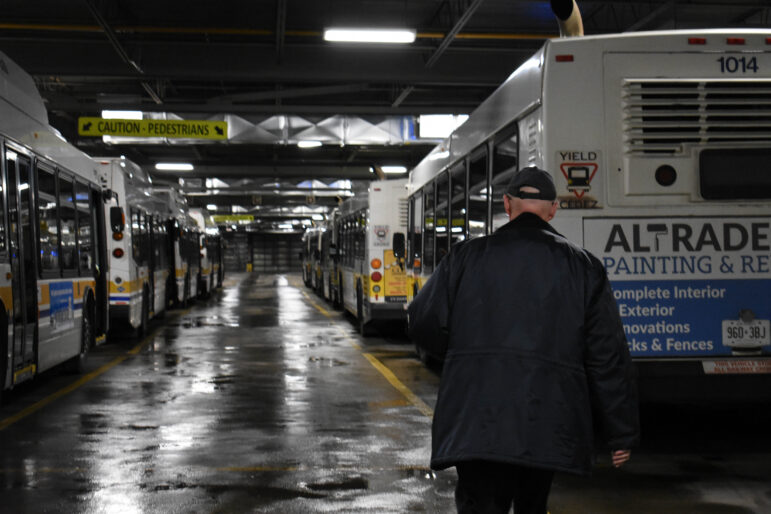
“I consider myself fortunate to be able to obtain a good paying job with good benefits that went a long way for me and my family”, Joe says as we hustle out of the lounge to the garage.
Joe is especially proud that he job “enabled my children to get a good education and start on their own careers”.
His eldest son is an aircraft mechanic, his daughter is a child care administration overseeing a large number of Early Year Centres, and his youngest son recently graduated from the physiology program at McMaster University.
It is now 4:40 a.m., most of Joe’s passengers haven’t even awaken for the day, but he’s fully alert as I struggle to keep up. Joe cuts in between a row of buses positioned so tightly together that an extra layer of winter jacket wouldn’t fit.
Moving quickly, as we pass the third column of buses, Joe turns around with a mischievous smile “Watch yourself, I’ve torn many a jacket over the years!”.
The HSR manager trailing us and I exchange glances, and decide to continue at Joe’s pace regardless of the risk to our nice jackets.
At the front of the garage sits the bus Joe will drive on this day.
He manually opens the doors, and starts his routine: positioning his candy on the dashboard first, he starts the bus engine, and starts punching the day’s transfer slips.
Joe loves his job down to the fine details. Each operator is assigned a unique punch for their transfers, prior to GPS tracking and the time accuracy of modern smartphones, the punch on a transfer slip was often the only means of identifying operators in the event of a rider compliant.
Joe set his eyes on a certain punch, and when it became available upon a retirement in the 1980s, he obtained a punch that created the number 1 in transfers. Number “1” to match his route.
Joe lost the punch a few years ago, but he made the best of it. Joe says his current punch makes hearts.
Joe says in his early days working at the HSR, operators carried quarters, payphones were the only means to contact HSR control as they didn’t yet have radios.
Computers would come in the 1980s, Joe quickly notes that thanks to his union, he was able to get computer familiarization training when a medical illness took him off the bus – he worked in the fare collection department during his work accommodation.
After punching his transfers, Joe quickly jumps out of the operator’s chair and off the bus to complete his circle check.
Lights, tires, even the emergency engine cut-off compartment all get checked with his flashlight. He makes sure the bus’ wheelchair ramp works, and now it’s time to leave the garage.
The Regulars
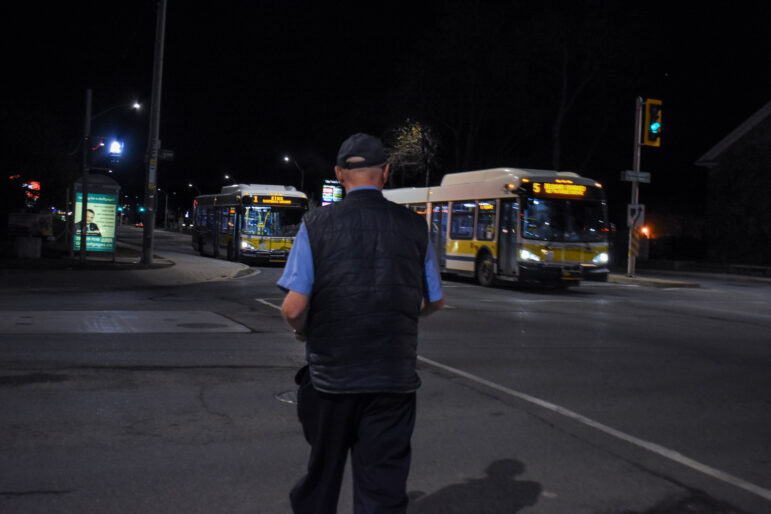
The first stop is the Tim Hortons at Upper James Street and Stone Church Road. The staff greet him as a regular, it’s now 4:55 a.m.
Onward down Upper James, Joe proceeds to Fennell Avenue. Left onto Fennell toward James Mountain Road. At West 2nd Street, Joe slows down looking for one of his regular passengers.
Joe says she regularly boarded his bus at the GO Centre, upon realizing she was transferring from the 27-Upper James, he told her that he drives by her stop and would pick her up, saving her 20 or so minutes each morning. She isn’t there this morning.
At the GO Centre, Joe has four transfers ready.
It’s 5:10 a.m., all the trains are sitting in their overnight storage spots, and a steady stream of HSR Mountain buses are bringing the first passengers of the day into the Downtown Core. There are a handful of cars on the road as the City slowly comes to life. Many of the passengers are employees of the City’s private garage collection contractor GFL, others are heading to the Stoney Creek industrial area, others still are service sector employees who will serve coffee to commuters who are not yet awake.
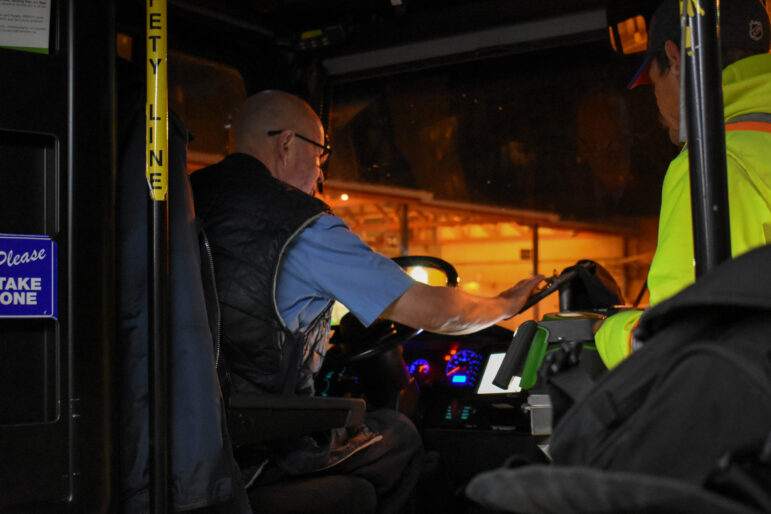
People get on board and greet Joe by name, Joe greets them by name.
Stops “move” at this hour of the morning, with the GFL employees being dropped at the driveway of the Queenston Traffic Circle Tim Hortons, likewise the stop at Queenston Road and Chapman Avenue moves a long half-block to the front of that Tim Hortons.
Joe fondly remembers the trolley buses. Whenever given the opportunity, driving into the Queenston Traffic Circle, he’ll talk about how Hamilton’s trolley wires were not custom installed for the system. ”
The circle was a series of 45 degree turns, many a rookie operator lost their poles here”, Joe says referring to when the trolley poles would come loose of the overhead wires.
In the early 1990s, the Regional Government “finally” rewired the trolley overhead wires to customize for the curves of Hamilton’s roadway. Shortly after spending millions on rewiring, Council axed trolley service as they slashed the HSR.
Joe was able to get a few souvenirs that were on their way to melted down for scrap.
He displays them in his garage these days, he’s hoping to add a vintage HSR location transmitter from the original tracking system to his collection. He’s working on connections in the Public Works department to get one, they still hang disconnected on old poles across the City.
At Eastgate Square, Joe stops behind another bus, opens the doors to disembark his passengers and is greeted by Fred [name changed]. Fred’s an old regular of Joe’s who now takes the bus ahead of Joe. Due to the Transit Crisis, many early morning passengers have adjusted their schedules to earlier buses, if Joe gets sick [which rarely happens], it is likely his bus won’t run that day.
Fred and Joe have playful banter, giving his other a hard time for a few minutes.
Joe notes that many of his early morning passengers are precariously employed, “they had their hours ‘temporarily’ cut back from full-time during the recession a decade ago, and they still only getting three or four days work each day”.
“This is why we need unions, to protect good jobs, and to bring good jobs back”, Joe adds.
Joe gets to know the people along his routes.
When I posted that I was writing this story on the occasion of Joe’s retirement, my social media lit up with tweets and Facebook comments from current and former Hamiltonians.
“He would wave at me”, says Bonnie-Jane Gairns who was a crossing guard for many years on Queenston Road. “My day off cause kids were sleeping in I would catch his bus to go to Eastgate Square and we would chat from Parkdale to Eastgate. He would make sure I got a chocolate or candy before I went shopping”.
“He’s a great driver!”
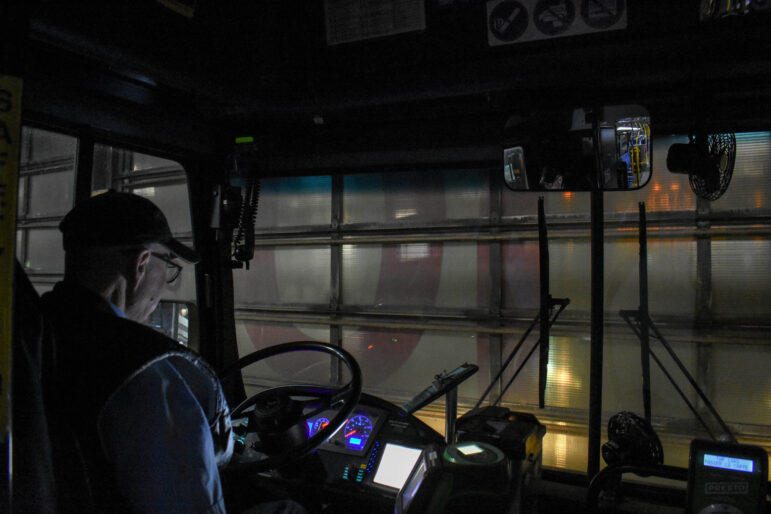
Caring for Passengers and More
In the 1980s, heading east out of the Wentworth and King garage, Joe saw a young woman sitting on the pavement in a city parking lot.
Joe stepped off the bus and offered her his hand. She was from St. Catharines and her boyfriend had dumped her, leaving her in Hamilton. She wasn’t sure where she was, when Joe arrived at the next payphone, he called her parents, and a few trips later, they picked her up at Eastgate Square.
Your reporter has his own experience of being “saved” by Joe to share.
Joe saved 14-year-old me from having to explain why I forgot a bag of football equipment on a HSR bus one night.
I didn’t look at the sign when I got on board, the bus went out of service at Sanford (heading to the 330 Wentworth North garage), and in my fluster, I got off the bus forgetting my bag.
Being in Grade 9, I thought this failure of responsibility was basically the end of the world. How would I explain this when I got to school that morning?
As I’m taking my morning Upper bus downtown to connect to the King, the forgotten equipment is all-consuming in my thoughts. I was really worried.
I was thinking of excuses, trying to figure out if I can get away with skipping class in the middle of the day to go to the HSR Lost and Found in the hope someone turned it in.
I board the same 1-King bus I take every morning at 8:02 a.m., the driver hands me my bag.
“Hey young man, I think you left this on the bus last night”
“How did the driver last night know I take this bus in the morning”, I asked as only a 14-year-old could naively ask.
“I’m the same driver, I take you home every night”, Joe responded.
This was the start of our friendship.
Joe says one of the reasons he loves driving at the HSR is all the friends he made over the years, and the stories.
About two years after this, Joe turned the tables on me one day. Each morning, I took Joe’s bus to school.
I often remarked that I was the “younger, better looking, with hair Joe”.
I’ll let Joe tell his version of the story of turning the table on me.
“Joey Coleman has rode my bus consistently from a young age”, Joe says. “In his younger years, Joey had a passion for bowtie donuts from Tim Hortons … one day I couldn’t resist, leaving Eastgate, Joey raised his bowtie, heavily laden with fresh whipped cream, ready to take a bite”.
“I gently tapped the brake which resulted in whipped cream being deposited all over his face!”, Joe says with a playful smile. “It was actually very funny, by the way, Joey finished the donut before cleaning up his mug”.
As I remember it different, Joe claimed he had suddenly been cut off by a car, I never did see that ghost car. Following this, I was always a little more careful that if I was going to be a smart ass, not to give Joe an easy way of returning the favour.
Safety
HSR’s fleet of 60-foot articulated buses are all equipment with closed-circuit video cameras for the rear-most doors.
Due to the smaller bus stop areas on the 1-King route, when articulated buses pull into many stops, they do so on an angle creating a blind spot. Operators could neither see the doors from inside the bus, nor using their outside-mounted mirrors.
Joe refused to operate articulated buses for this safety reason, and worked with management on the solution to the blind spot, the CCTVs resulted.
While never a health and safety representative, Joe’s been a key advisor to many union presidents over the years.
Weekends, Hockey, Church, Speakers, and Grandkids – Joe Off The Bus
It took Joe almost twenty years driving HSR buses before he had the seniority to get weekends off.
He quickly got involved with his children’s minor hockey association, and remained involved until recently, almost 20 years, long after his kids had aged out of minor hockey.
Joe, and his wife Nancy, are involved in their church parish, St. Patrick’s Church at King Street and Victoria Avenue. [Disclosure: I attend the parish, but a different mass time than the Kipps]
They were heavily involved in the church’s roof replacement campaign, and in recent years, Joe has gone nearly every week to Costco buying hundreds of dollars worth of coffee and snacks each time to donate to the parish’s Demazenod Door Outreach.
Of this, Joe says he gives of his means. “I’m very fortunate to be lucky enough to have a strong union job”.
Thanks to his job, Joe was able to put his computer familiarization training to use in another one of his passions.
In the 1990s, Joe got himself dial-up Internet and launched himself into e-commerce selling custom built loudspeakers (Joe’s online handle remains kippsoundman to this day). He sold speakers as a hobby venture, it let him build speakers. He stopped selling online, but still builds custom speakers. Most recently, he built a set for auction at his youngest son’s Stag and Doe.
Joe’s passion these days are his grandchildren.
Joe drives the 1-King with the earliest shift ending time. As most of us go for lunch, Joe gets off his bus at 11:57 a.m. at King Street and Hughson Street Downtown, the end of his workday. He takes the HSR home, picks up his vehicle, and drives to pick up his grandchildren.

Retirement
Joe retires tomorrow, he’s “had his numbers” to retire for nearly a decade now. Many thought Joe would never retire, he loves the job that much, and were caught by surprise when he announced his plans earlier this fall.
“He’s a great ambassador”, says current ATU 107 President Eric Tuck. “He’s really one of a kind”.
“I don’t know how we replace the bubble driver”, Tucks chuckles with a smile. Tuck and other operators hope to do something to celebrate Joe in 2018, likely around the 40th anniversary of his start at the HSR in June.
Joe does not wish for retirement gifts, saying the friendships he’s built over the years are more than enough.
“Christmas season has always been a treat for me. Because I’ve stayed on the same route for so long, my regular passengers always bring me treats”, Joe says of this time of year.
Many passengers bring Joe cards and gifts of various varieties, including “enough Tim cards to satisfy my coffee craving well into February and maybe March”.
Joe doesn’t have any special plans for his retirement, more time with his family and grandchildren are at the top of the list. He plans to work part-time at the HSR, especially as the HSR works to hire enough operators in the coming months, and remains short-staffed.
His first part-time shift as a retiree will be New Years’ Eve, he’ll be driving the 2:30 a.m. last 1-King bus after people ring in the New Year. It will also be the first time Joe will drive a 1-King east of Eastgate since his days driving trolleys.
Last Day
For his last day as a full-time bus operator, Joe is giving all his passengers coffee and donuts.
“Treats on me!”, Joe says. “Not one day has felt like work to me out here, people have made my career great”.
Joe hopes many old friends will join him Friday for one last ride before the officially retires stepping off this 1-King at 11:57 a.m. at King Street and Hughson Street.
Joe’s first departure from the GO Centre is 5:15 a.m. going eastbound to Eastgate Square.
- 5:55 a.m. depart Eastgate Square to University Plaza, 6:25 a.m. at King and Hughson
- 6:45 a.m. depart University Plaza to Eastgate, 7:22 a.m. at Main and MacNab
- 8:00 a.m. depart Eastgate Square to University Plaza, 8:31 a.m. at King and Hughson
- 9:05 a.m. depart University Plaza to Eastgate Square, 9:36 a.m. at Main and MacNab
- 10:06 a.m. depart Eastgate Square to Hamilton GO Centre, 10:39 at King and Hughson
- 10:48 a.m. depart Hamilton GO Centre to Eastgate Square
- 11:24 a.m. depart Eastgate Square to King and Hughson. Officially off the bus at 11:57 a.m. at King and Hughson.

